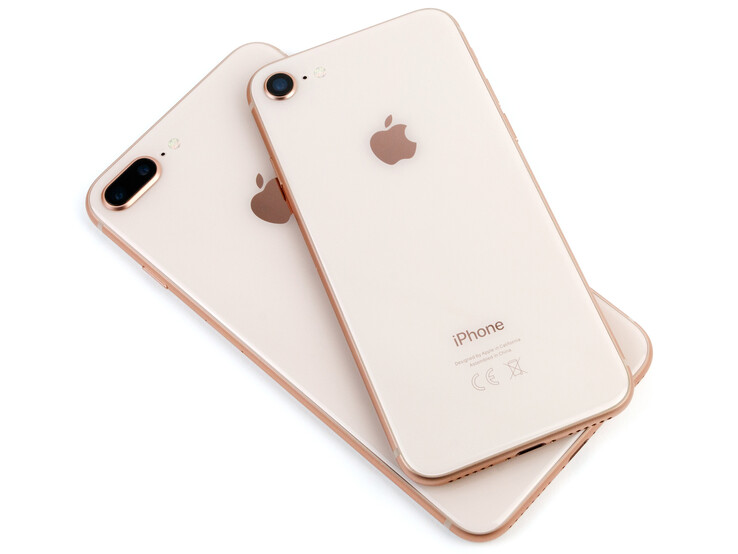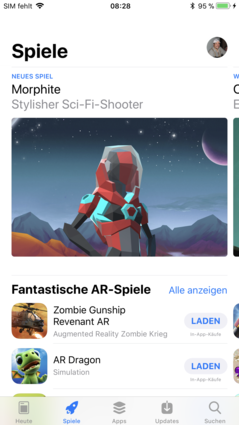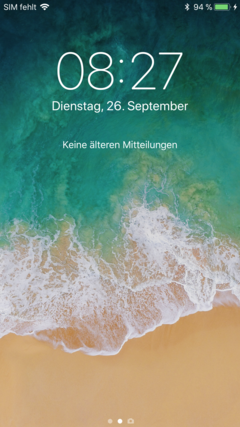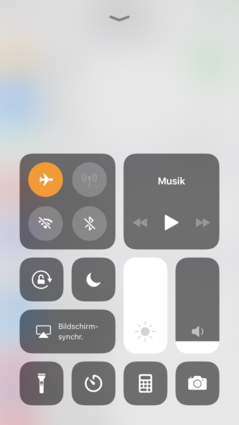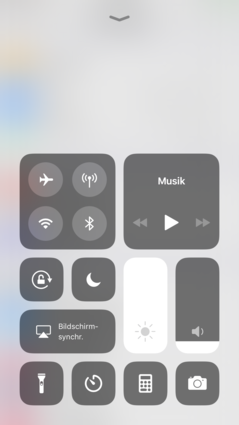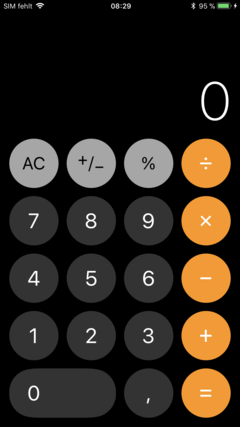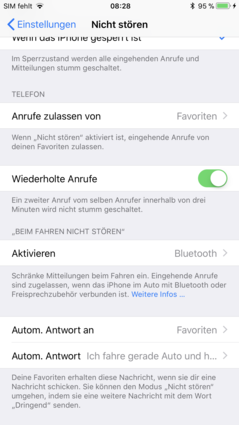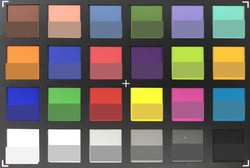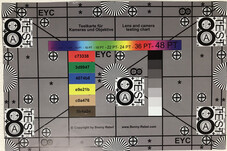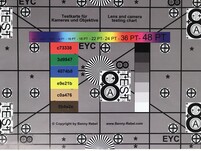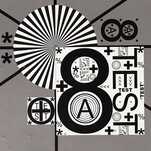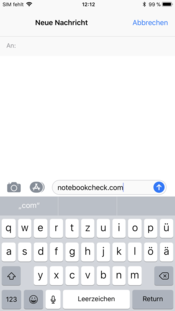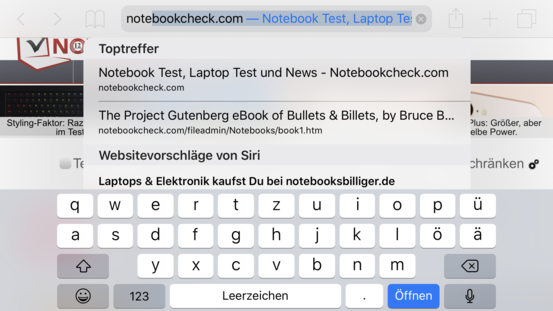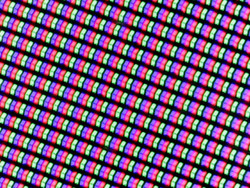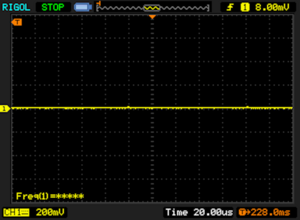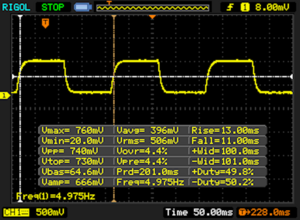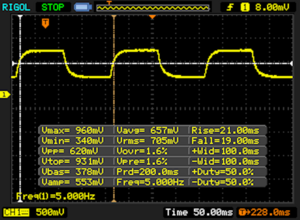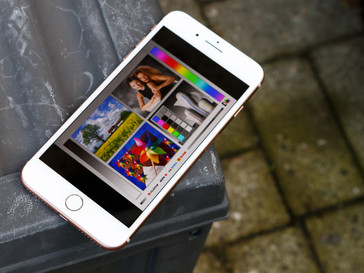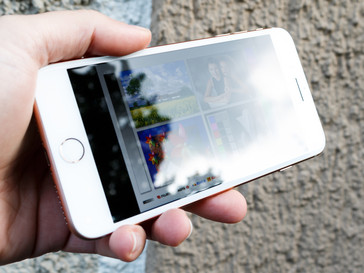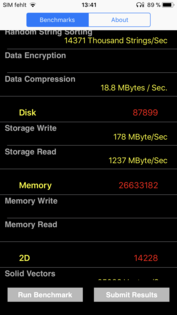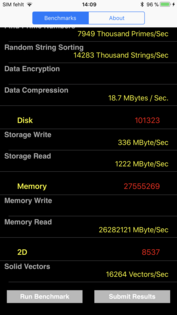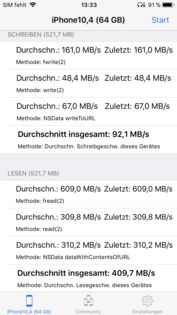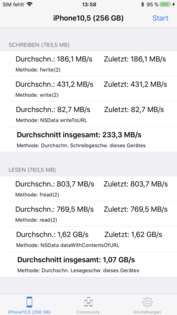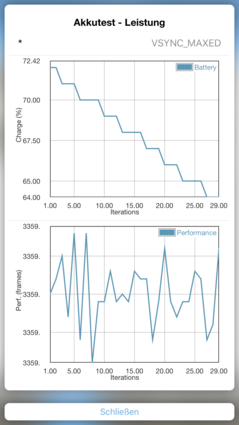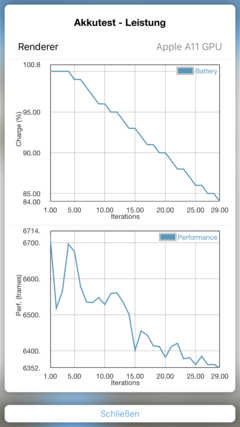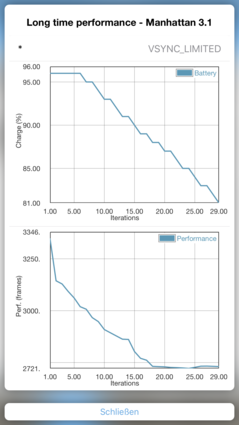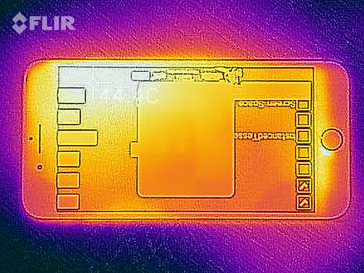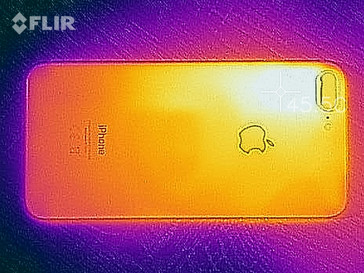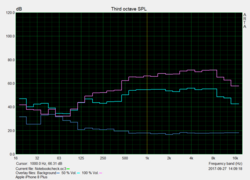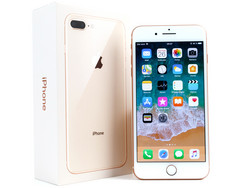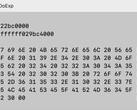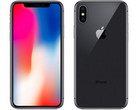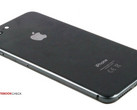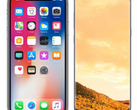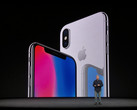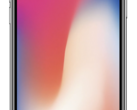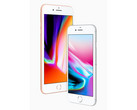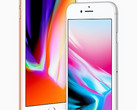Apple iPhone 8 Plus Smartphone Review
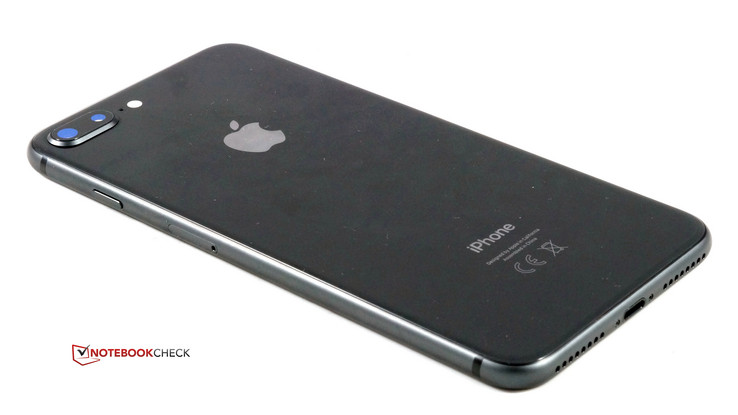
For the original German review, see here.
Since the iPhone 6, Apple has always launched two new smartphones in autumn. This year, however, we get three. Two of them are direct successors to the 7th generation with the labels iPhone 8 & iPhone 8 Plus. The third new device for 2017 is the anniversary model, the iPhone X, which is about to be launched on November 3rd. Potential buyers can start to pre-order on October 27th and try to get one of the first models. A bit of luck will probably be required, though, since the first batch is most probably very limited.
There are two obvious differences between the Apple iPhone 8 Plus and the iPhone 8: the screen size and the camera equipment. The Plus model once again uses a 5.5-inch screen in combination with a dual-camera. We will have a closer look at both features further below. The components differ slightly as well: Apple has equipped the Plus model with a larger battery, which is a result of the larger chassis, as well as 3 GB of RAM instead of 2 GB that is in the smaller iPhone 8.
As with the smaller sibling, the case dimensions are slightly larger than before, and it is also slightly heavier, but you cannot really notice it in practice. This is not the case for the glossy rear panel, though. It feels more comfortable in the hands, but is prone to fingerprints and slips more easily. The latter is a bigger issue for the Plus model when you use it with just one hand. Apple says it is the most robust glass used on a smartphone, but user experiences will soon show whether this is true or not.
The 5.5-inch Apple iPhone 8 Plus is obviously equipped with Apple's new A11 Bionic as well. The SoC consists of two high-performance and four efficiency cores. The three-core GPU is the first GPU fully designed by Apple. The manufacturer promises performance gains between 30-70%, depending on the application. The graphics API Metal 2 and an AR engine (Augmented Reality) for games and other apps are two additional new features.
As with the iPhone 8, which will be referred to frequently times in this preview, you can only get the iPhone 8 Plus in three colors and two storage sizes. Our test model, which was purchased from Apple's online store, is the Space Gray model (also available in Silver and Gold). We ordered the 256 GB model for 1079 Euros ($949); the 64 GB model retails for 909 Euros ($799).
Case
As with the smaller sibling, the case dimensions are slightly larger than before, and it is also slightly heavier, but you cannot really notice it in practice. This is not the case for the glossy rear panel, though. It feels more comfortable in the hands, but is prone to fingerprints and slips more easily. The latter is a bigger issue for the Plus model when you use it with just one hand. Apple says it is the most robust glass used on a smartphone, but user experiences will soon show whether this is true or not.
Nothing has changed in terms of the mediocre screen-to-body-ratio for the larger iPhone model. While the side bezels are conveniently slim, Apple still wasted a lot of possible display space at the top and bottom. The iPhone 8 Plus is therefore much larger than a Samsung Galaxy S8, which is equipped with a 0.3-inch bigger display. This will change with the iPhone X this November.
There is absolutely no criticism for the choice of materials and build quality. Both are on a very high level and you cannot twist or dent the iPhone 8 Plus, even with a lot of pressure. Quite the contrary: There is not even a quiet creaking sound.
Connectivity
Except for the dual-camera, the display size, and the battery capacity, the connectivity is identical on both new iPhone models, so we want to refer to the review of the smaller iPhone 8.
Purchasing the larger iPhone 8 Plus costs an additional 110 Euros (~$150) over the smaller model. The tested top model with 256 GB of storage, which was bought in the Apple online store, retails for 1079 Euros ($949). The 64 GB model is available for 909 Euros ($799).
Software
It is common for Apple to launch an update for its own mobile operating system a few days ahead of the new iPhone launch. iOS 11 is already installed on the iPhone 8 models. There has been no minor update so far, even though some users started complaining about some bugs. Bluetooth supposedly does not work reliably with all accessories, and the battery runtimes are lower ... but these complaints are typical for every major update. One simple reason is that users just use their phones more often after an update. We did not encounter any errors or unusual behaviors during our review, except for the changes and new features obviously.
iOS 11 is the same for the two new iPhones, so the content in the two articles is identical. You can skip the following part if you have already read the article about the sibling.
Let us start with the design. Many fonts are now larger and sometimes bold, which makes it easier to differentiate between headings/categories and options/items. The better readability applies to the whole system, but there is sometimes less space for the content. All in all, iOS 11 is easier to read compared to previous versions.
The lock screen and the notification center are now combined, while the Control Center has been reduced to one page with smaller individual symbols. Wi-Fi and Bluetooth cannot be disabled via Control Center anymore. It only terminates active connections, but the wireless modules stay active. Apple says the connections should be kept turned on for important functions, such as contact with the Apple Watch or Apple Pencil. You can still deactivate the wireless connections, either via settings, or by activating Airplane mode. You can also see the difference in the Control Center. The symbols will be gray when you only terminate active connections, and the icon will be crossed out when the modules are turned off.
iPhone users have had to wait for a long time before they get a full file manager. iOS 11 now introduces the app "Files", which gives you comfortable access to different file sources such as iCloud, Dropbox, Google Drive, etc. Copying files from and to a source works. You still cannot access the file system, but we did not really expect that in the first place.
The App Store has had a complete visual overhaul. It does not look so crowded anymore, but Apple has managed to include all the important information. The store is also faster than before. Apple has also improved many more aspects of iOS. You can now edit Live Photos such as videos, screenshots can be edited directly and forwarded without saving them first. iOS also shows a small preview in the lower left corner of the display after you take the shot. A tap on the thumbnail within three seconds will open the Edit menu. Otherwise, the preview will disappear and the screenshot is saved as usual.
It is now possible – also automatically if you want – to activate the option "Do not disturb while driving" when you drive. The iPhone will not light up the display when you get a message, and the sender can get a message that the recipient is driving right now.
The automatic configuration of new devices or the transfer of Wi-Fi passwords to devices nearby work well, and both features are realized via NFC. Setting up a new device is now much faster, and you only need a working iOS device close by the new device. You then have to scan a kind of bar code on the display and the automatic configuration starts. Unfortunately, the activation of the function did not work all the time in our case.
Apple's iOS 11 includes many useful features and the design has also improved. However, the user loses a bit of control if he wants to turn off the wireless connections via Control Center, but you should get used to it. All in all, we think iOS 11 is a successful update.
The storage requirements are a big advantage of iOS 11, especially for buyers of the 64 GB version. Only ~6 GB of the internal storage is occupied ex-works, which is roughly half of that of the predecessor.
Communication and GPS
The iPhone 8 Plus and iPhone 8 use the same wireless modules. You either get wireless radios from Qualcomm or Intel, depending on the region. Both modules support Gigabit LTE and therefore probably the Cat. 16 standard, but Apple does not specify it. The manufacturer from California does not make any compromises in terms of wireless bands and supports numerous bands for FDD and an above-average number of bands for TDD-LTE, so there should not be any connectivity issues, even in Asia.
Wireless connections are handled by a Wi-Fi module according to IEEE-802.11 a/b/g/n/ac in 2.4 as well as 5 GHz networks. The new ad-standard is not supported, but the ZenFone 4 Pro is already announced for this year, which can transfer data at up to 4.6 Gbps via Wi-Fi with the appropriate peripherals. In theory, the iPhone 8 Plus can transfer files at up to 1 Gbps via MIMO technology, but we cannot quite reach this level in practice. The transfer rate in combination with our reference router Linksys EA8500 is really good when the smartphone receives data. The iPhone manages 914 Mbps on average and can secure the top spot among the smartphone competition. It is not so fast when you send data, and the result is pretty average. Only the Mate 9, which lacks MIMO technology, is slower within the comparison group. The range of the connection is good and also strong through a basement ceiling.
NFC for near-field communications is also included, but there are still limitations. The iPhone 8 Plus is also the first smartphone that can actually use Bluetooth 5.0, while the Android competition still awaits the Oreo update. Connecting multiple Bluetooth devices is no problem for the iPhone 8 Plus, but it cannot play music on more than one audio peripheral simultaneously, unlike the Galaxy S8+.
As with the smaller sibling, the Apple iPhone 8 Plus is equipped with a very accurate GPS module. The recorded track is again slightly longer compared to our reference navigation device Garmin Edge 500. The iPhone 8 Plus shows only small deviations on our MTB trail, and all of these deviations add up to the slightly longer distance. The bridge crossing is one example where the professional navigation device is closer to the track, but the differences are very small. It is no problem to use the iPhone 8 Plus for navigation purposes for different activities such as driving, MTB rides, hiking, and Geo Caching.
Telephone Functions and Voice Quality
The voice quality is not that different from the smaller sibling. We also tested the Apple iPhone 8 Plus in the T-Mobile network (3G and LTE) to a landline.
The ear piece works well on the larger iPhone 8. The voice of the caller is loud and clear, and the maximum volume can be very high. We noticed the same problems as on the iPhone 8 when using the hands-free functionality: The voice sounds slightly tinny, and the speakers are a bit too quiet in general.
Our voice was perfectly audible on the other side of the call – at least in an LTE network and as long as the environment was not too noisy. We noticed infrequent short dropouts in 3G networks and with ambient noise. The noise suppression works well in quieter environments though.
Cameras
The front camera of the Apple iPhone 8 Plus has a 7 MP sensor with an aperture of f/2.2. It supports an automatic HDR mode, electronic image stabilizer, Full HD video and all the other features that we are already familiar with from the iPhone 7 Plus and the iPhone 8. However, the manufacturer has tweaked the software slightly, so the results are noticeably better. Low-light pictures could benefit from higher light sensitivity, and some Android competitors perform much better in this scenario.
The dual-camera at the back uses a completely new ISP (Imaging Signal Processor), which was developed by Apple. The wide angle lens has similar specifications to the smaller iPhone including the aperture of f/1.8. The Telephoto enables a 2x optical zoom, but the lens captures less much light at an aperture of f/2.8. All of this is similar to the iPhone 7 Plus, and the optical image stabilizer is still limited to the wide angle lens; dual-OIS is reserved for the iPhone X. The second lens enables the completely reworked portrait mode. Not only can it focus on the object and create a nice bokeh effect, but it can also simulate five different lighting situations. The feature was not final as of this writing, but we already liked the results a lot and you can create great pictures.
The zoom feature is also really good in decent lighting situations, but you can quickly see picture noise in darker environments. The Note 8 and the OnePlus 5 are two rivals that use the second lens as a zoom. We compared them in daylight and all of them produced good results, but based on different principles. The Note 8 is particularly sharp around the focal points, but objects on other levels are slightly blurry and less detailed. The OnePlus 5 manages a steady sharpness with high contrasts, but you can see some artifacts when you zoom in. Our test model is somewhere in between, so some spots do not look as good as on the Note 8, which has occasional problems with the autofocus in return.
Pictures taken with the iPhone 8 Plus have comparatively natural colors, high dynamic range and conveniently sharp structure. There is no criticism in daylight, especially since the trigger is even quicker and there is an automatic HDR mode. Details are shown even more accurately by the Galaxy Note 8 though. The iPhone also performs well in low-light situations and the results show a higher contrast compared to the Galaxy Note 8, but the sensor does not capture as much light in a short time, and you can also see picture noise.
The video feature is a highlight since the iPhone 8 Plus camera can record Ultra HD videos at 60 frames per second. None of the rivals has managed this so far, and this feature is usually reserved for professional video cameras or high-end DSLRs as well as system cameras priced over 2000 Euros (~$2354). The compression rate is also very high, so one minute of 4K video at 60 FPS needs "only" about 400 MB. The result is really good, despite the high compression. You can also select different resolutions, which is handy.
The handling is not perfect, because Apple is traditionally very light on settings. RAW pictures can only be taken with third-party apps and there is no manual mode. There is currently no other smartphone that can offer such a high quality of pictures and videos in one device.
We took another look at the performance of the main camera the iPhone 8 Plus under controlled lighting conditions. It is very similar to the smaller sibling and some colors (red, yellow, orange, and green) are slightly paler. Colors such as dark blue, cyan, and purple are more saturated.
The test chart picture taken with the main camera reveals similar results compared to the iPhone 8. Color gradients are very convenient and even dark letters on dark backgrounds are extremely sharp. However, some details are lost even in the center of the picture; the sharpness drop towards the edges is okay. The wide angle lens also performs well, but this sensor loses more details and the sharpness drop towards the edges is more pronounced.
Warranty and Accessories
Apple has not changed its warranty regulations compared to the previous model, which means that Apple still ships the iPhone 8 plus with a 12-month warranty. You can purchase the optional Apple Care+ for $129. This includes phone support and additional hardware coverage for a total of two years. The latter is limited to two accidental damages, but you will still have to pay a service fee. Screen damage is $29 and any other damage is $99. Please see our Guarantees, Return Policies & Warranties FAQ for country-specific information.
The box contains a meager 5-watt power adapter, a Lightning headset, an adapter from Lightning to stereo jack, a small SIM tool as well as some brochures for the set-up, warranty and safety information.
Apple offers a huge number of accessories in its shop, even from third-party vendors. There is a new category for wireless-charging products. Apple sells corresponding charging stations at prices starting at 65 Euros (~$76). The Californian manufacturer uses the popular Qi standard though, so you can also use any other inexpensive solution.
Input Devices & Handling
Apple does not usually change too much when new iPhones are launched. You get a new SoC, often new cameras as well as display, but the input devices and the handling usually remain unchanged. The previous model got the touch sensitive Home button, but that was the only major change for the iPhone 7 Plus in this section. And what about the iPhone 8 Plus? Well, not much to talk about. Apple supposedly uses a new and extremely robust glass, but this does not change the handling.
However, this is not necessary. The touchscreen has worked perfectly on iPhones for years and is one of the best you can get. It is precise all the way up to the corners, there is hardly any delay and the gliding capabilities are convenient. The dedicated buttons do not fall behind: They are perfectly integrated into the case, are easy to find with the finger and have clearly defined pressure points.
The upcoming iPhone X will use facial recognition, but the Touch ID fingerprint scanner of the Apple iPhone 8 Plus still works really well. The sensor recognizes your finger very reliably as long as the finger is not too moist. The round shape unfortunately still wastes a lot of space, so the Plus model is bigger than necessary.
Display
The display section is very similar to the smaller sibling: Size and resolution have not changed, so we still get a 5.5-inch Full HD display. The only new feature is True Tone, which works just as inconspicuously as on the smaller iPhone 8.
Our measurements leave mixed impressions. Both the grayscale performance and the color accuracy are very good, but the new iPhone 8 Plus falls behind the previous model in some respects. The current model is slightly worse in terms of luminance (538 nits on average), black value (0.38 cd/m²), and contrast (1471:1). The results are still good, but the display is not among the best smartphone displays anymore. We are eager to see whether the OLED panel on the iPhone X can change that.
Let us have a closer look at the grayscale and color accuracy. All the deviations for the grayscale are smaller 3 and therefore not perceptible to the human eye, which is also the case for the slightly cool color temperature. The performance for the primary and mixed colors in the sRGB gamut is even slightly better, and the saturation is excellent. Many less expensive competitors have problems in this respect. It is no surprise that the panel covers almost the full sRGB color space.
| |||||||||||||||||||||||||
Brightness Distribution: 90 %
Center on Battery: 559 cd/m²
Contrast: 1471:1 (Black: 0.38 cd/m²)
ΔE ColorChecker Calman: 1.3 | ∀{0.5-29.43 Ø4.77}
ΔE Greyscale Calman: 1.8 | ∀{0.09-98 Ø5}
99.9% sRGB (Calman 2D)
Gamma: 2.25
CCT: 6797 K
| Apple iPhone 8 Plus A11 Bionic GPU, A11 Bionic, Apple 256 GB (iPhone 8 / Plus) | Apple iPhone 8 A11 Bionic GPU, A11 Bionic, Apple 256 GB (iPhone 8 / Plus) | Apple iPhone 7 Plus A10 Fusion GPU, A10 Fusion, 128 GB NVMe | Samsung Galaxy S8 Plus Mali-G71 MP20, Exynos 8895, 64 GB UFS 2.1 Flash | Huawei Mate 9 Mali-G71 MP8, Kirin 960, 64 GB UFS 2.1 Flash | |
|---|---|---|---|---|---|
| Screen | 4% | 4% | -7% | -74% | |
| Brightness middle (cd/m²) | 559 | 604 8% | 557 0% | 560 0% | 696 25% |
| Brightness (cd/m²) | 538 | 580 8% | 553 3% | 562 4% | 680 26% |
| Brightness Distribution (%) | 90 | 91 1% | 97 8% | 93 3% | 93 3% |
| Black Level * (cd/m²) | 0.38 | 0.44 -16% | 0.35 8% | 0.42 -11% | |
| Contrast (:1) | 1471 | 1373 -7% | 1591 8% | 1657 13% | |
| Colorchecker dE 2000 * | 1.3 | 1.2 8% | 1.4 -8% | 1.7 -31% | 4.3 -231% |
| Colorchecker dE 2000 max. * | 2.7 | 2.3 15% | 3.1 -15% | 3.4 -26% | 9.4 -248% |
| Greyscale dE 2000 * | 1.8 | 1.6 11% | 1.3 28% | 1.6 11% | 4.8 -167% |
| Gamma | 2.25 98% | 2.25 98% | 2.21 100% | 2.13 103% | 2.33 94% |
| CCT | 6797 96% | 6688 97% | 6667 97% | 6435 101% | 7255 90% |
| Color Space (Percent of AdobeRGB 1998) (%) | 63.1 | 81.57 | |||
| Color Space (Percent of sRGB) (%) | 99.83 | 99.87 |
* ... smaller is better
Screen Flickering / PWM (Pulse-Width Modulation)
| Screen flickering / PWM not detected | |||
In comparison: 53 % of all tested devices do not use PWM to dim the display. If PWM was detected, an average of 8084 (minimum: 5 - maximum: 343500) Hz was measured. | |||
Display Response Times
| ↔ Response Time Black to White | ||
|---|---|---|
| 24 ms ... rise ↗ and fall ↘ combined | ↗ 13 ms rise | |
| ↘ 11 ms fall | ||
| The screen shows good response rates in our tests, but may be too slow for competitive gamers. In comparison, all tested devices range from 0.1 (minimum) to 240 (maximum) ms. » 53 % of all devices are better. This means that the measured response time is worse than the average of all tested devices (20.2 ms). | ||
| ↔ Response Time 50% Grey to 80% Grey | ||
| 40 ms ... rise ↗ and fall ↘ combined | ↗ 21 ms rise | |
| ↘ 19 ms fall | ||
| The screen shows slow response rates in our tests and will be unsatisfactory for gamers. In comparison, all tested devices range from 0.165 (minimum) to 636 (maximum) ms. » 60 % of all devices are better. This means that the measured response time is worse than the average of all tested devices (31.6 ms). | ||
You can use the Apple iPhone 8 Plus outdoors pretty comfortably as long as you avoid direct sunlight. The larger iPhone is not quite as bright as the smaller sibling, so it falls behind a bit. However, the ambient light sensor is very sensitive and always uses the right luminance. The iPhone 8 Plus also benefits from the surface, which is not too glossy. Keep the display clean and you can recognize the contents even in bright environments.
The panels of the iPhone 8 Plus and iPhone 8 seem to differ in other aspects except for the size and resolution. It is otherwise hard to explain why the smaller model is noticeably brighter and the viewing angle stability of the 8 Plus is not quite as good, either. Colors get a bit darker and the contrast drop is bigger compared to the smaller sibling. This is not perfectly represented by the pictures, but the overall result is still decent.
Performance
Quote from the Apple iPhone 8 preview: "Apple advertises another big performance gain for the new A11 Bionic, especially in Multithreaded scenarios. Phil Schiller talked about the performance advantages of 25% compared to the A10 performance cores during the keynote. The four efficient Mistral cores are even 70% faster than before, according to Apple, which was limited to two efficient cores. Apple uses 4.3 billion transistors for the die. This is particularly impressive since the AMD Ryzen 7, a modern desktop processor, has only 500000 transistors more.
Apple's first in-house GPU is supposed to be very powerful as well. Not only should it be up to 30% faster than the PowerVR from the iPhone 7, but Apple has also reduced the power consumption by 50%."
The Apple iPhone 8 Plus is equipped with 3 GB of RAM, which results in a small advantage over the iPhone 8 in all the benchmarks that we have run so far. The performance of the Apple A11 Bionic is impressive, and the comparison with the Android flagships shows that the new iPhones will be hard to beat. The differences are sometimes significant, so you might think you are comparing the iPhone against older Android devices. Just two examples: The iPhone 8 Plus scores 10559 points in Geekbench 4, while the closest Android rival, the Samsung Galaxy Note 8, achieves 6744 points. This is not even the Geekbench version optimized for Metal, where the iPhone scores 15295 points. The difference in web-based scenarios is just as drastic. Mozilla Kraken 1.1 ranks the 8 Plus up to 280% ahead of the flagship competition (Huawei Mate 9).
| Geekbench 4.4 | |
| 64 Bit Single-Core Score (sort by value) | |
| Apple iPhone 8 Plus | |
| Apple iPhone 8 | |
| Apple iPhone 7 | |
| Huawei Mate 9 | |
| Samsung Galaxy S8 Plus | |
| Samsung Galaxy Note 8 | |
| 64 Bit Multi-Core Score (sort by value) | |
| Apple iPhone 8 Plus | |
| Apple iPhone 8 | |
| Apple iPhone 7 | |
| Huawei Mate 9 | |
| Samsung Galaxy S8 Plus | |
| Samsung Galaxy Note 8 | |
| Compute Metal Score 4.1 (sort by value) | |
| Apple iPhone 8 Plus | |
| Apple iPhone 8 | |
| Apple iPhone 7 | |
| AnTuTu v6 - Total Score (sort by value) | |
| Apple iPhone 8 Plus | |
| Apple iPhone 8 | |
| Apple iPhone 7 | |
| Huawei Mate 9 | |
| Samsung Galaxy S8 Plus | |
| Samsung Galaxy Note 8 | |
| Octane V2 - Total Score (sort by value) | |
| Apple iPhone 8 Plus | |
| Apple iPhone 8 | |
| Apple iPhone 7 | |
| Huawei Mate 9 | |
| Samsung Galaxy S8 Plus | |
| Samsung Galaxy Note 8 | |
| Mozilla Kraken 1.1 - Total (sort by value) | |
| Apple iPhone 8 Plus | |
| Apple iPhone 8 | |
| Apple iPhone 7 | |
| Huawei Mate 9 | |
| Samsung Galaxy S8 Plus | |
| Samsung Galaxy Note 8 | |
| WebXPRT 2015 - Overall (sort by value) | |
| Apple iPhone 8 Plus | |
| Apple iPhone 8 | |
| Apple iPhone 7 | |
| Huawei Mate 9 | |
| Samsung Galaxy S8 Plus | |
| Samsung Galaxy Note 8 | |
* ... smaller is better
The GPU of the iPhone 8 Plus, which was developed by Apple for the first time, is also one of the best on the market. This is not really surprising, but unlike the CPU part of the A11 Bionic, the GPU cannot beat all rivals in all the tests. Samsung's Galaxy Note 8 in particular can keep up with the iPhone 8 Plus in 3DMark. The Note 8 is sometimes ahead and sometimes behind the Apple smartphone. However, the Android competition does not stand a chance in the GFX benchmark.
| GFXBench (DX / GLBenchmark) 2.7 | |
| T-Rex Onscreen (sort by value) | |
| Apple iPhone 8 Plus | |
| Apple iPhone 8 | |
| Apple iPhone 7 | |
| Huawei Mate 9 | |
| Samsung Galaxy S8 Plus | |
| Samsung Galaxy Note 8 | |
| 1920x1080 T-Rex Offscreen (sort by value) | |
| Apple iPhone 8 Plus | |
| Apple iPhone 8 | |
| Apple iPhone 7 | |
| Huawei Mate 9 | |
| Samsung Galaxy S8 Plus | |
| Samsung Galaxy Note 8 | |
| GFXBench 3.0 | |
| on screen Manhattan Onscreen OGL (sort by value) | |
| Apple iPhone 8 Plus | |
| Apple iPhone 8 | |
| Apple iPhone 7 | |
| Huawei Mate 9 | |
| Samsung Galaxy S8 Plus | |
| Samsung Galaxy Note 8 | |
| 1920x1080 1080p Manhattan Offscreen (sort by value) | |
| Apple iPhone 8 Plus | |
| Apple iPhone 8 | |
| Apple iPhone 7 | |
| Huawei Mate 9 | |
| Samsung Galaxy S8 Plus | |
| Samsung Galaxy Note 8 | |
| GFXBench 3.1 | |
| on screen Manhattan ES 3.1 Onscreen (sort by value) | |
| Apple iPhone 8 Plus | |
| Apple iPhone 8 | |
| Apple iPhone 7 | |
| Huawei Mate 9 | |
| Samsung Galaxy S8 Plus | |
| Samsung Galaxy Note 8 | |
| 1920x1080 Manhattan ES 3.1 Offscreen (sort by value) | |
| Apple iPhone 8 Plus | |
| Apple iPhone 8 | |
| Apple iPhone 7 | |
| Huawei Mate 9 | |
| Samsung Galaxy S8 Plus | |
| Samsung Galaxy Note 8 | |
Web performance – iOS devices have always been the benchmark in this discipline, and this does not change with the new model. Well, something has changed, because the performance jump is even greater compared to the previous generation. Thanks to more RAM, the iPhone 8 Plus is just ahead of its sibling, followed by the iPhone 7 models (minus 30-55%) over all browser tests. Then we have the Android flagships with a respectable difference. Samsung's top models S8 Plus and Note 8 fall about 60% behind in Google's Octane v2. This is increased to about 70% in JetStream 1.1, and the iPhone 8 Plus is miles ahead in Mozilla's Kraken 1.1. We certainly do not have to mention that web browsing is extremely fast in practice, but you still will not notice a difference compared to the predecessor.
| Octane V2 - Total Score (sort by value) | |
| Apple iPhone 8 Plus | |
| Apple iPhone 8 | |
| Apple iPhone 7 | |
| Huawei Mate 9 | |
| Samsung Galaxy S8 Plus | |
| Samsung Galaxy Note 8 | |
| JetStream 1.1 - Total Score (sort by value) | |
| Apple iPhone 8 Plus | |
| Apple iPhone 8 | |
| Apple iPhone 7 | |
| Huawei Mate 9 | |
| Samsung Galaxy S8 Plus | |
| Samsung Galaxy Note 8 | |
| Mozilla Kraken 1.1 - Total (sort by value) | |
| Apple iPhone 8 Plus | |
| Apple iPhone 8 | |
| Apple iPhone 7 | |
| Huawei Mate 9 | |
| Samsung Galaxy S8 Plus | |
| Samsung Galaxy Note 8 | |
| WebXPRT 2015 - Overall (sort by value) | |
| Apple iPhone 8 Plus | |
| Apple iPhone 8 | |
| Apple iPhone 7 | |
| Huawei Mate 9 | |
| Samsung Galaxy S8 Plus | |
| Samsung Galaxy Note 8 | |
* ... smaller is better
Apple sells only two storage versions of the iPhone 8 Plus: 64 GB and 256 GB. Apple does not specify any details except for the capacity. Teardowns only speak of NAND-storage, but we are probably once again dealing with NVMe storage due to the high transfer rates. The 64 GB version still had 55 GB free after the set-up; the larger version had around 244 GB.
As with the previous iPhone 7, we can see performance advantages for the larger model, sometimes even significant ones. The 256 GB model is about twice as fast in the PassMark Write test, while the read performance is almost identical. DiskBench shows even bigger differences, and the 256 GB model is around 150% faster in all disciplines. This is not perceptible in day-to-day situations, only if you copy large amounts of data onto the smartphone
| DiskBench 64 GB | DiskBench 256 GB | PassMark 64 GB | PassMark 256 GB | |
|---|---|---|---|---|
| Read | 409.7 MB/s | 1.07 GB/s | 1237 MB/s | 1222 MB/s |
| Write | 92.1 MB/s | 233.3 MB/s | 178 MB/s | 336 MB/s |
Games
All the games in the App Store are tested and certified and they run on the identical ecosystem, so they should perform without any hiccups – especially on the latest generation. It is therefore not surprising that most games lack any settings for details and effects – they are just not necessary.
What this means is that even more demanding games such as “Asphalt 8: Airborne” run perfectly smoothly; there are neither stutters nor graphics errors. Simpler titles or 2D games are no challenge for the Apple iPhone 8 Plus. Augmented Reality for gaming is a new feature, but many of the initial games are not full AR titles and only place animals in the environment. Titles such as “The Machines AR” use the new possibilities better, even though the reality is often covered by the game board. AR titles also suffer from the lack of a depth camera, so the figures are not always placed perfectly.
The gaming experience also benefits from the excellent control options. The most important part is obviously the touchscreen, which executes inputs quickly and reliably. The position sensor is also very accurate and enables fine movements. In short: Gaming is fun on the new iPhone 8 Plus.
Emissions
Temperature
The surface temperatures of the Apple iPhone 8 Plus are very good while idling and usually stay below 30 °C (~86 °F), only some spots at the front are slightly warmer. The iPhone 8 Plus stays slightly cooler than the smaller iPhone and only some spots exceed 40 °C (~104 °F). However, the PSU can be very warm at 46.4 °C (~115 °F), but this value is still harmless.
We use the GFXBench Battery test to check how the Apple A11 handles sustained workloads. While the iPhone 8 passed the lighter T-Rex test (Metal or OpenGL ES 2.0) with ease, the Plus model loses some performance (up to -5.4%) in the Metal test. The smartphone manages much more FPS with the Metal API, but also consumes more power. The iPhone 8 Plus also produces less frames than the smaller model in the Manhattan test (Metal API), but there is still some throttling, even though the drop is not as sharp. All in all, the iPhone 8 Plus loses up to 19% of its original frame rate.
(±) The maximum temperature on the upper side is 40.7 °C / 105 F, compared to the average of 35.2 °C / 95 F, ranging from 21.9 to 247 °C for the class Smartphone.
(±) The bottom heats up to a maximum of 40.6 °C / 105 F, compared to the average of 34 °C / 93 F
(+) In idle usage, the average temperature for the upper side is 28.1 °C / 83 F, compared to the device average of 32.9 °C / 91 F.
Speakers
The speakers of the Apple iPhone 8 Plus have not changed compared to last year's model. You still get a dual-speaker setup, one at the bottom of the case and the other one inside the earpiece. The calibration is slightly better than before with more balanced mids, but real bass is not perceptible. The speakers still provide a comparatively good sound experience, although the maximum volume could have been higher. The iPhone at least manages to beat the HTC U11, but it is beaten by the sound quality of the Huawei P10 Plus.
The stereo jack is still missing, but the box includes a Lightning headset as well as an adapter from Lightning to 3.5 mm stereo jack, so you can still use conventional headphones. The performance of the connector is unchanged and decent in general, but it cannot compete with the HTC U11 or other high-quality alternatives.
Apple iPhone 8 Plus audio analysis
(±) | speaker loudness is average but good (80.1 dB)
Bass 100 - 315 Hz
(-) | nearly no bass - on average 17.1% lower than median
(±) | linearity of bass is average (7.5% delta to prev. frequency)
Mids 400 - 2000 Hz
(+) | balanced mids - only 2.7% away from median
(+) | mids are linear (4.5% delta to prev. frequency)
Highs 2 - 16 kHz
(+) | balanced highs - only 4.3% away from median
(+) | highs are linear (3.8% delta to prev. frequency)
Overall 100 - 16.000 Hz
(±) | linearity of overall sound is average (16.5% difference to median)
Compared to same class
» 7% of all tested devices in this class were better, 5% similar, 88% worse
» The best had a delta of 11%, average was 35%, worst was 134%
Compared to all devices tested
» 27% of all tested devices were better, 6% similar, 67% worse
» The best had a delta of 4%, average was 24%, worst was 134%
Huawei P10 Plus audio analysis
(±) | speaker loudness is average but good (75.6 dB)
Bass 100 - 315 Hz
(-) | nearly no bass - on average 17.3% lower than median
(±) | linearity of bass is average (12.4% delta to prev. frequency)
Mids 400 - 2000 Hz
(+) | balanced mids - only 3.1% away from median
(+) | mids are linear (6.9% delta to prev. frequency)
Highs 2 - 16 kHz
(+) | balanced highs - only 1% away from median
(+) | highs are linear (3.9% delta to prev. frequency)
Overall 100 - 16.000 Hz
(±) | linearity of overall sound is average (16.8% difference to median)
Compared to same class
» 9% of all tested devices in this class were better, 7% similar, 85% worse
» The best had a delta of 11%, average was 35%, worst was 134%
Compared to all devices tested
» 29% of all tested devices were better, 7% similar, 64% worse
» The best had a delta of 4%, average was 24%, worst was 134%
HTC U11 audio analysis
(±) | speaker loudness is average but good (81.4 dB)
Bass 100 - 315 Hz
(-) | nearly no bass - on average 24.5% lower than median
(±) | linearity of bass is average (13.3% delta to prev. frequency)
Mids 400 - 2000 Hz
(+) | balanced mids - only 4.1% away from median
(±) | linearity of mids is average (7.4% delta to prev. frequency)
Highs 2 - 16 kHz
(±) | higher highs - on average 5.1% higher than median
(+) | highs are linear (6.2% delta to prev. frequency)
Overall 100 - 16.000 Hz
(±) | linearity of overall sound is average (22.1% difference to median)
Compared to same class
» 46% of all tested devices in this class were better, 7% similar, 47% worse
» The best had a delta of 11%, average was 35%, worst was 134%
Compared to all devices tested
» 63% of all tested devices were better, 6% similar, 30% worse
» The best had a delta of 4%, average was 24%, worst was 134%
Frequency Comparison (Checkboxes select/deselectable!)
Energy and Battery Runtime
Power Consumption
The small iPhone consumed more than its predecessor while idling, and this is also the case for the iPhone 8 Plus. The maximum consumption is higher as well, but both new iPhone models consume less power under medium workloads. We do not expect similar or even longer runtimes compared to the previous model, especially since the battery of the Apple iPhone 8 Plus has a smaller capacity (-6.7%).
We measure 0.72 W (iPhone 7 Plus: 0.77 W) with the minimum luminance and deactivated wireless modules. The maximum luminance in combination with Airplane mode consumes 2.45 W (iPhone 7 Plus: 2.04 W); with wireless modules 2.52 W (iPhone 7 Plus: 2.24 W).
The maximum consumption during the challenging Relative Benchmark was increased to more than 9 W, while the value under medium workloads – we play “Asphalt 8: Airborne” for this scenario – dropped significantly. 3.84 W is more than 1 W less compared to the direct predecessor.
We can cite the review of the sibling when we talk about the power adapter: The provided power adapter is once again insufficient. The iPhone 8 Plus pulls up to 6 W from the PSU. You need the power adapter from the iPad to charge the battery under maximum load. Apple should really change that, especially with the announced quick-charge functionality in mind.
A full charge of the iPhone 8 takes 3:03 hours with the provided 5 W adapter (5 V, 1 A) while idling. This is not that much longer compared to the rivals, but the battery capacity is much lower in return. You can reduce the charging time with a more powerful power adapter. Apple advertises a charge to 50% within 30 minutes with a corresponding power adapter.
| Off / Standby | |
| Idle | |
| Load |
|
Key:
min: | |
Battery Runtime
Before the first minor iOS 11 update, our text in this section was the following: "As with the smaller sibling, Apple does not give us any specific figures in terms of battery runtime, and only says the current generation is roughly on par with the previous model. Apple has also equipped the iPhone 8 Plus with a slightly smaller battery compared to the iPhone 7 Plus, but expects the A11 chip to compensate for that. As with the iPhone 8, this does not work. We start with the practical runtime tests. Our Wi-Fi test uses a script that opens a website every 30 seconds at an adjusted luminance of 150 nits and deactivated wireless modules except for Wi-Fi. The result is on par with another iPhone, but not the iPhone 7 Plus. 8:20 hours is just one minute more compared to the smaller sibling, but it loses 17% compared to the previous model.
The deficit is even greater with the loop of a Full HD video. Wi-Fi is deactivated for this test, but the other settings are identical. About 11 hours is 14% ahead of the smaller model, but still 20% shorter than the predecessor. It cannot compete with the Android rivals, either. The good load result (3:31 hours) does not change that, and we are disappointed by the stamina of the iPhone 8 Plus in general."
We have had to revise our verdict after the update to iOS 11.0.1. Instead of mediocre 8:20 hours in the Wi-Fi test, the Apple iPhone 8 Plus now manages a very good result of almost 11 hours after the minor update. The runtime in the video test also increases to more than 12 hours, but it is still not as enduring as the predecessor.
| Apple iPhone 8 Plus A11 Bionic GPU, A11 Bionic, Apple 256 GB (iPhone 8 / Plus) | Apple iPhone 8 A11 Bionic GPU, A11 Bionic, Apple 256 GB (iPhone 8 / Plus) | Apple iPhone 7 Plus A10 Fusion GPU, A10 Fusion, 128 GB NVMe | Samsung Galaxy S8 Plus Mali-G71 MP20, Exynos 8895, 64 GB UFS 2.1 Flash | Huawei Mate 9 Mali-G71 MP8, Kirin 960, 64 GB UFS 2.1 Flash | Sony Xperia XZ Premium Adreno 540, SD 835, 64 GB UFS 2.0 Flash | Google Pixel XL 2016 Adreno 530, SD 821, 32 GB eMMC Flash | OnePlus 5 Adreno 540, SD 835, 64 GB UFS 2.1 Flash | |
|---|---|---|---|---|---|---|---|---|
| Battery runtime | -10% | -1% | 5% | 6% | 3% | -21% | -12% | |
| Reader / Idle (h) | 34.8 | 27.2 -22% | 30.6 -12% | 26.1 -25% | 25.6 -26% | 29.2 -16% | 22.2 -36% | 25.6 -26% |
| H.264 (h) | 12.2 | 11.6 -5% | 13.6 11% | 12.4 2% | 15.8 30% | 13.4 10% | 8.4 -31% | 10.4 -15% |
| WiFi v1.3 (h) | 11 | 9.8 -11% | 9.8 -11% | 12.3 12% | 12.6 15% | 11.6 5% | 8.4 -24% | 8.6 -22% |
| Load (h) | 3.5 | 3.4 -3% | 3.8 9% | 4.6 31% | 3.7 6% | 3.9 11% | 3.8 9% | 4.1 17% |
Verdict
Pros
Cons
The iPhone 8 Plus offers slightly more than its smaller sibling. We are not only talking about the pure weight, which is substantial at more than 200 grams (~7 oz), but mainly the dual-camera. The display also features more pixels and you get 1 GB more RAM. The reworked case with the glass rear panel leaves mixed impressions. The build quality is great, and it is pleasant to the touch. However, the surface looks smeared after a few minutes. The Plus model is also really big for a smartphone with a 5.5-inch display.
The camera is quite similar to the iPhone 7 Plus and the second lens offers a 2x optical zoom. It also enables the soft Bokeh effect for portraits, which look quite good. The picture quality in general has improved compared to the previous model, and you can now record Ultra HD videos at up to 60 frames per seconds. Full HD is possible at up to 240 FPS, which creates spectacular slow motions. The iPhone 8 Plus is certainly the best overall camera package you can currently get in a smartphone – if you like the essential settings menu.
The iPhone 8 Plus is a great choice for video enthusiasts. If you plan to purchase it for this purpose, however, you should be willing to pay for the larger 256 GB model, because 4K @ 60 FPS requires a lot of storage space.
The new A11-SoC is once again much faster and out of reach of the rivals. You also get fast LTE, long battery runtimes, and a case with water and dust resistance. As with its smaller sibling, we cannot find any major flaws, but some things are annoying. These include the limited warranty and the weak power adapter. The voice quality could be better in 3G networks and the sound is just average, despite stereo speakers.
Apple's move towards Augmented Reality is important and will certainly be successful, thanks to the large platform and the enormous user potential for fast and profitable technology advancements. AR already works well, but it is still not as accurate or sophisticated compared to the Asus ZenFone AR, for example.
All in all, the iPhone 8 Plus is a great product with high-end components, but both the smartphone and useful accessories are also very expensive.
Apple iPhone 8 Plus
- 10/15/2018 v6 (old)
Daniel Schmidt, Patrick Afschar Kaboli




